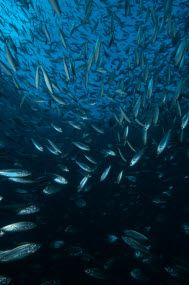
|
| Fish farms have long been known to be 'hot spots' of wild fish aggregation. Photo: Arturo Boyra |
Sea-cage fish farms are widespread in Norway's coastal waters and farms are increasing in both number and size. Over 1000 farms operate and use around 800 000 tons of fish food each year.
Fish farms have long been known to be 'hot spots' of wild fish aggregation. Research in the Mediterranean Sea over the past 5 years has demonstrated that farms have hundreds to thousands times more wild fish around them than in habitats distant from farms. Fish such as pollack, cod and mackerel are also known to gather around fish farms in Norway but little is known of the ecological effects of farms on these wild fish.
The project will determine how attractive fish farms are to wild fish with underwater video camera systems at 9 farms along the Norwegian coast (3 near Tromsø, 3 in Trøndelag and 3 in Hardangerfjord) and 9 natural locations without farms.
The project will also collect wild fish (pollack, cod and mackerel) at farms and wild fish distant from farms to determine if fish size, diet, body condition and parasite loads differ when they are associated with farms.
The information generated on the species and numbers of wild fish that are attracted by fish farms and how their association with farms affects fundamental aspects of their biology will assist managers to devise strategies to increase the positive effects and minimise any negative environmental effects of fish farms in coastal waters.
Contact:
